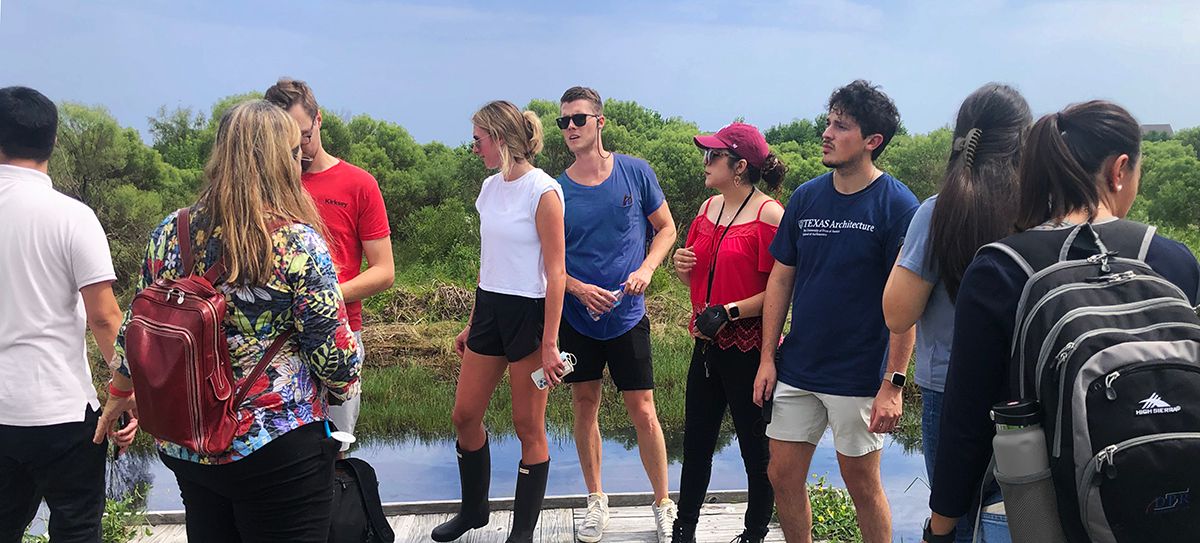
SUSTAIN
Fall 2021 | Crenshaw School of Environmental Studies | Port Bolivar TX
Project Team: Phase I: design and build structure: Mariana Aviana, Stefan Brits, Alfredo Corona, Emily Dauskurdas, Jonathan Malott, Chi-Shen Ni, Melannie Ruiz, Zein Tao. / Phase II: complete the roof: Michael Anowey, Andrew Brandt, Joesph Chandler, Heather Corcoran, Alvaro, Favela-Ramos, Gabriel Friedstadt, Judy Labib, Curtis Lechner, Kassandra Lee, Taylor Luehr, Hannah Oppelt, Andre Rezaie, Maxwell Vela
This project is a new field station for Crenshaw School for Environmental Studies on Bolivar Peninsula. Crenshaw is a magnet K-8th grade school for the Galveston County school system. Children attending the school live on the peninsula and are majority Hispanic, many from lower income families. Descendants from one of the first colonial settlers in the area—the Crenshaws—donated forty acres—wetlands and coastal prairie—that has become an outdoor laboratory for the students. The school’s pedagogy is driven by hands-on outdoor learning where children not only have firsthand learning experiences in their local environment, they also grow vegetables and other domesticated plants and they spend time in the wetlands and coastal prairie observing, sketching, water coloring local plant and animal life, to learn about their own backyard to grasp the intricate ecological interdependence occurring there.
One thing the school needed for outdoor learning like this was a place to comfortably sit and do their exercises while being protected from the sun and frequent showers that occur on the coast. This is where the Gulf Coast DesignLab students stepped in to remedy the shortcoming by building a small field station that would, not only offer comfort but inspire. The new field station needed to accommodate up to twenty-four students under roof with designated areas adjacent to the structure for yoga, drum circles and overflow teaching when larger groups are there.
After touring the school, getting to know the teachers and students and spending time on site to get a deeper sense of the local environment, GCDL students set out to define design opportunities that could become teaching moments for the kids. One feature that they developed was an outdoor water trough—3 ft high, 1’-6” ft wide and 26 ft long—that collects rain from the slightly pitched roof through a series of rain chains that channel rainwater down. The long water pool is made of steel that will patina to a soft reddish color. When complete, the trough will become home to native water plants and Gambusia fish (mosquito fish), all intended to become a self-supporting eco-system that builds student’s basic understanding of ecological principles. To the west is a wood screen that shields the afternoon sun. It’s planted with native coral honeysuckle that will become a teaching tool about plant life diversity that addresses invasive species, which have overrun much of the school’s property. There is also a season’s calendar in the form of a thirty-foot long concrete “mark” in the ground on the east side of the structure. Cast into it are laser-cut plaques with naming the winter and summer solstice and spring/fall equinox. Computer modeling was used to locate these times showing when seasons change. This is designated by the eastern roof overhang that casts a shadow over the respective plaques on their strategic dates, tracking the sun’s shift of latitude in the sky. Additionally, the latitude and longitude of the field station’s location on earth is laser cut into a steel plague attached to the structure’s floor. Tables and benches made of western red cedar and steel that will patina like the water trough, were made to accommodate twenty-four children at time. Because the physical size of the school’s students is wide ranging—kindergarten through eighth grade—GCDL students had to find a median height that would be comfortable for all. There is a galvalume R-panel roof overhead, supported by a hot-dipped galvanized steel frame. The deck and structure are made of 2x dimensional lumber, pressure treated. As an educational place focusing on environmental studies, the goal of the school and the intention of the GCDL students who designed and built the structure was to provide a pleasing place that motivates a new generation of environmental stewards who appreciate the natural beauty of what is around them, prompting a desire to protect and nurture it.